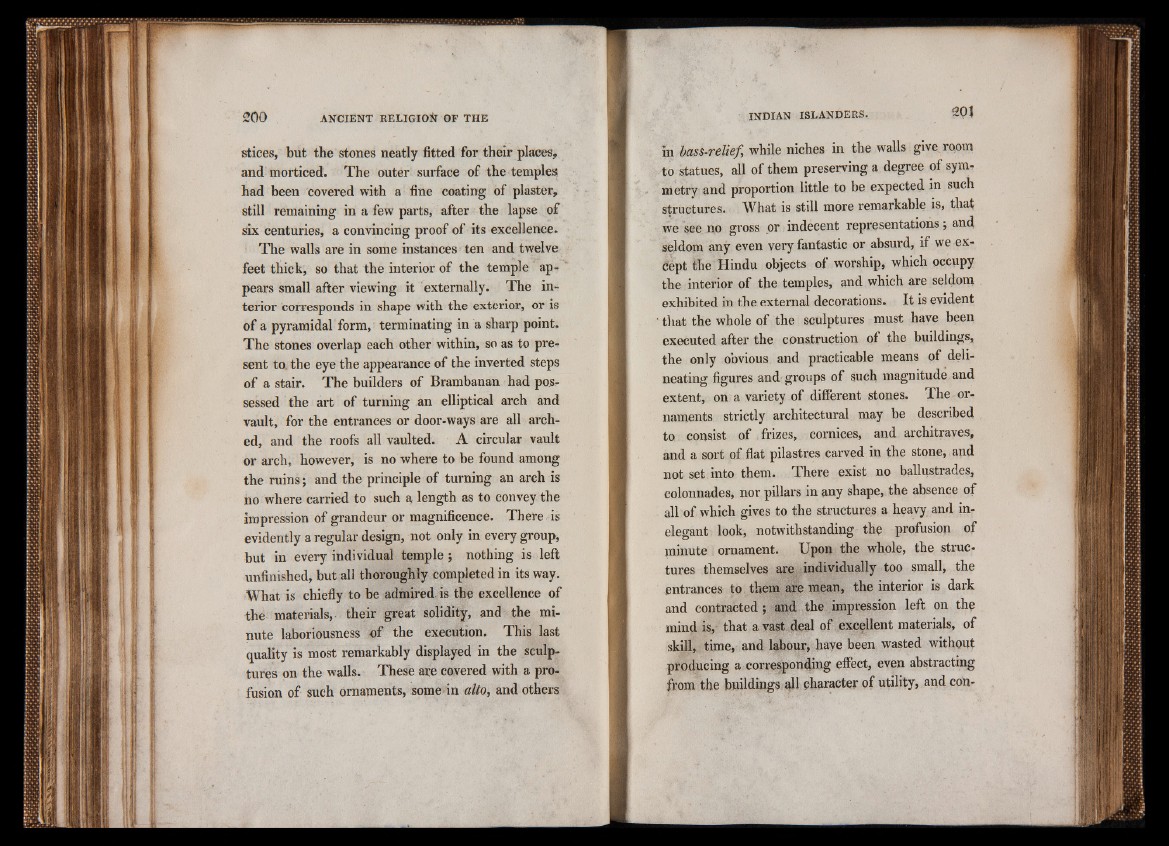
200
stices, but the stones neatly fitted for their places,
and morticed. The outer surface of the temples
had been covered with a fine coating of plaster,
still remaining in a few parts, after the lapse of
six centuries, a convincing proof of its excellence.
The walls are in some instances ten and twelve
feet thick, so that the interior of the temple appears
small after viewing it externally. The interior
corresponds in shape with the exterior, or is
of a pyramidal form, terminating in a sharp point.
The stones overlap each other within, so as to present
to, the eye the appearance of the inverted steps
of a stair. The builders of Brambanan had possessed
the art of turning an elliptical arch and
vault, for the entrances or door-ways are all arched,
and the roofs all vaulted. A circular vault
or arch, however, is no where to be found among
the ruins; and the principle of turning an arch is
no where carried to such a length as to convey the
impression of grandeur or magnificence. There is
evidently a regular design, not only in every group,
but in every individual temple ; nothing is left
unfinished, but all thoroughly completed in its way.
What is chiefly to be admired is the excellence of
the materials, their great solidity, and the minute
laboriousness of the execution. This last
quality is most remarkably displayed in the sculptures
on the walls. These are covered with a profusion
of such ornaments, some in alto, and others
in bass-relief, while niches in the walls give room
to statues, all of them preserving a degree of symmetry
and proportion little to be expected in such
structures. What is still more remarkable is, that
we see no gross or indecent representations ; and
seldom any even very fantastic or absurd, if we ex-
<?épt the Hindu objects of worship, which occupy
the interior of the temples, and which are seldom
exhibited in the external decorations. It is evident
that the whole of the sculptures must have been
executed after the construction of the buildings,
the only obvious and practicable means of delineating
figures and groups of such magnitude and
extent, on a variety of different stones. The ornaments
strictly architectural may be described
to consist of frizes, cornices, and architraves,
and a sort of flat pilastres carved in the stone, and
not set into them. There exist no ballustrades,
colonnades, nor pillars in any shape, the absence of
all of which gives to the structures a heavy and inelegant
look, notwithstanding the profusion of
minute ornament. Upon the whole, the structures
themselves are,individually too small, the
entrances to. them are mean, the interior is dark
and contracted ; and the impression left on the
mind is, that a vast, deal of excellent materials, of
skill, time, and labour, have been wasted without
producing a corresponding effect, even abstracting
from the buildings all character of utility, and con